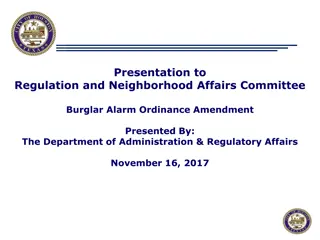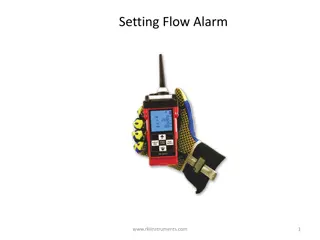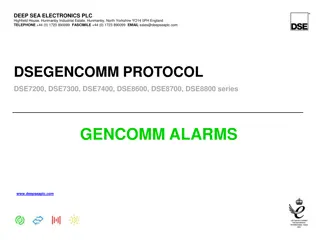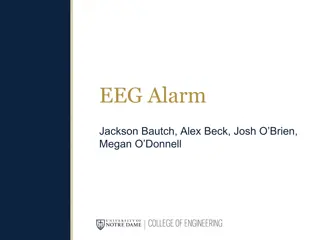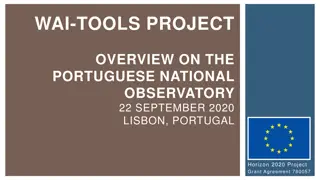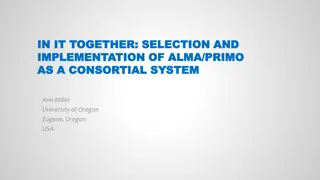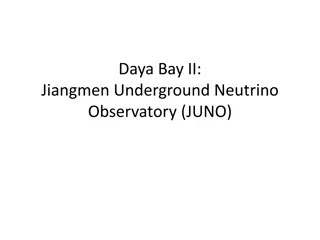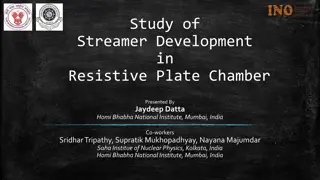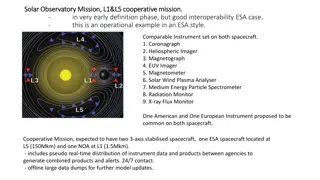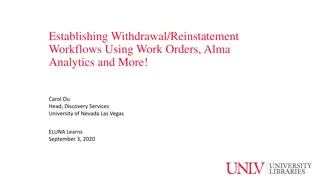Integrated Alarm System for ALMA Observatory Architecture - Development Overview
Detailed documentation from ALMA-CTA meetings showcasing the development stages and components of the Integrated Alarm System for the ALMA Observatory. Includes insights on alarm systems, computing elements, distributed units, and implementation strategies discussed in Garching meetings.
Download Presentation

Please find below an Image/Link to download the presentation.
The content on the website is provided AS IS for your information and personal use only. It may not be sold, licensed, or shared on other websites without obtaining consent from the author. Download presentation by click this link. If you encounter any issues during the download, it is possible that the publisher has removed the file from their server.
E N D
Presentation Transcript
Integrated Alarm System for the ALMA Observatory Achitecture Alessandro Caproni ESO Software Development Division
ALMA alarm systems Operator panels Integrated Alarm System Alarms and monitor points Software systems Garching, 12/12/2016 ALMA-CTA Meeting 2
Development study Garching, 12/12/2016 ALMA-CTA Meeting 3
Current status Vague and confused ideas A growing prototype Garching, 12/12/2016 ALMA-CTA Meeting 4
IAS core Distributed Alarm System Units Outputs DASUs Inputs Garching, 12/12/2016 ALMA-CTA Meeting 5
IAS core Alarm System Computing Elements DASU ASCE7 ASCE6 ASCE4 ASCE5 ASCE3 ASCE2 ASCE1 CONVERSION LAYER Garching, 12/12/2016 ALMA-CTA Meeting 6
IAS Core Alarm System Computing Element out Inputs sent on changes out refreshed at a given time interval Validity Inputs and output share the same type out = 1..n( .) 1 n Garching, 12/12/2016 ALMA-CTA Meeting 7
(AKA Transfer Function) brief calculation on the inputs no remote access or I/O Dynamically load from CDB Implementation Java/scala Python? DSL? Garching, 12/12/2016 ALMA-CTA Meeting 8
ASCE state machine INIT Load TF Init TF initialized shutdown TF BROKEN Idle HEALTHY Run TF broken slow shutdown TF SLOW Run TF normal shutdown shutdown SHUTDOWN Shut down TF close CLOSED Garching, 12/12/2016 ALMA-CTA Meeting 9
Putting all together Server 2 Server 1 JVM1 JVM1 JVM2 Garching, 12/12/2016 ALMA-CTA Meeting 10
Identifiers DASU ASCE7 ARRAY01@ LOCKED@ASC5@ARRAY01 ASCE6 ASC4@ARRAY01 ASCE4 ASCE5 TEMP@DBCONVERTER@ARRAY01 ASCE3 ASCE2 ASCE1 CURRENT@POWERP@PWDASU DBCONVERTER@ARRAY01 CONVERSION PLUGIN Garching, 12/12/2016 ALMA-CTA Meeting 11
Communication with subsystems Online IAS server(s) Weather BSDB Power plant Garching, 12/12/2016 ALMA-CTA Meeting 12
Communications HIOs passing between ASCEs and DASUs Commands (to DASUs, from GUIs..) GUIs (RTI)DDS? Message passing (ZMQ, ActiveMQ..)? Actors (Akka)? Garching, 12/12/2016 ALMA-CTA Meeting 13
Back stage DB HIOs produced at run time High load (reading/writing HIOs, logs, commands) GUIs read HIOs from there Cassandra already in use for monitoring seems a good candidate Garching, 12/12/2016 ALMA-CTA Meeting 14
Configuration DB Stores HIOs, ASCE, DASUs configuration Deployment configuration A RDB suffices here (Oracle? Mysql?) On files (JSON, XML..)? Cassandra could be evaluated if we want to use only one technology Garching, 12/12/2016 ALMA-CTA Meeting 15
GUIs Roles Web server (JS, angular?) Java FX for local (command line) GUIs Google/apple notifications for mobile Nice to have: support for mobile applications Garching, 12/12/2016 ALMA-CTA Meeting 16
Prototype Infrastructure (ant, jenkins, git ) scala, java, python, shell Implementation Logging HIO types ASCE with (scala/java) DASU (on going) Garching, 12/12/2016 ALMA-CTA Meeting 17
Thats all! Garching, 12/12/2016 ALMA-CTA Meeting 18
example: multiplicity def eval(compInputs: Map[String, HeteroInOut], actualOutput: HeteroInOut): HeteroInOut = { if (compInputs.size<threshold) throw new UnexpectedNumberOfInputsException(compInputs.size,threshold) if (actualOutput.iasType!=ALARM) throw new TypeMismatchException(actualOutput.id.runningID,actualOutput.iasType,ALARM) for (hio <- compInputs.values if hio.iasType!=ALARM) throw new TypeMismatchException(actualOutput.id.runningID,hio.iasType,ALARM) // Get the number of active alarms in input var activeAlarms=0 val numOfActiveAlarms = for { hio <- compInputs.values alarmValue = hio.actualValue.get.value.asInstanceOf[AlarmValue] if (alarmValue.alarmState==AlarmState.Active)} activeAlarms=activeAlarms+1 // Update the output if (activeAlarms>=threshold) { actualOutput.updateValue(AlarmValue.transition(actualOutput.actualValue.get.value.asInstanceOf[AlarmValue], new Set())) } else { actualOutput.updateValue(AlarmValue.transition(actualOutput.actualValue.get.value.asInstanceOf[AlarmValue], new Clear())) } } Garching, 12/12/2016 ALMA-CTA Meeting 19



